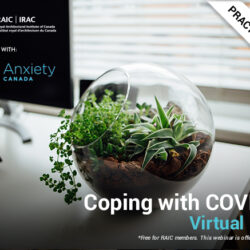This website uses cookies so that we can provide you with the best user experience possible. Cookie information is stored in your browser and performs functions such as recognising you when you return to our website and helping our team to understand which sections of the website you find most interesting and useful.
RAIC Catalyst For Change – Ian Mulder

December 2023
To celebrate and honour RAIC volunteers, we are pleased to introduce you to Ian Mulder, Chair of the RAIC Edmonton Network.
Thank you, Ian!
Why did you decide to become an architect?
I did an undergrad degree in philosophy and fine arts and later worked as a professional artist for many years. Some of my projects involved collaboration with architects, and I began to recognize the importance of good design, particularly in the public realm. I also recognized that a lot of the things I was good at and enjoyed in my art practice related very well to the architectural practice. So, I decided to change my life, move to Toronto and go back to school!
How long have you been an RAIC member and what do you see as the value of your membership?
I joined the RAIC when I was a graduate student because I recognized the value of participation in a national professional body. More recently, I became the Chair of the Edmonton Chapter because I wanted to help support the profession locally and hopefully bring people together for live community-building events post-Covid.
Why do you volunteer for the RAIC?
I volunteer because I believe in the value of the profession and believe that a strong national organization is important to improve the prominence of it nationwide. A strong RAIC helps to communicate the value of the practice to the general public.
What do you find most challenging about working as an architect?
What is most challenging- and perhaps most exciting- is that we work at a variety of scales all the time. One moment you might be working with planners on zoning requirements and the next, adjusting a minute detail.
Why is this area of advocacy important to you?
The general public may not always understand all the things that architects do or can do. In an era of multiple crises and where we know that buildings are a major contributor to waste and greenhouse gas emissions, the importance of the profession in delivering the collective goals of society have never been more important. It is critical that we as a profession communicate that value through advocacy.
What do you think will most change/shape practice over the next five years?
There are ever expanding means of project procurement that impact our practice- notably single contract IPD approaches that modify the traditional role of the architect as Prime Consultant. Ongoing and ever-increasing environmental performance goals of clients and government will continue to drive change. AI seems to be another as-yet unknown that will likely impact everyone.
What role do you see the RAIC and architects playing in terms of climate action, truth and reconciliation, and procurement reform, among other issues that matter?
Because building is a deeply human endeavour and one of our most ancient, architects will continue to be near the centre of these conversations. These days there are many interests that compete for the time and attention and dollars of everyone.
What do you like to do outside of architecture?
Build things, work with wood, spend time with my family, and ride my bike.
What advice would you have for those looking to get more involved in advocacy causes related to architecture?
Do it! The world needs your voice. Plus, you’ll meet tons of people that might change your mind.
How do you incorporate diversity, equity and inclusion in your work environment, the built environment and your volunteer work?
On a personal level I find the diversity of people to be amazing and interesting. And on a professional level, a tremendous value-add to almost any endeavour. Because architects design for people, it seems critical that those doing the designing also reflect those using the buildings. In music, diverse melodies can create fantastic and hitherto unknown harmonies.
Recommended Reading
Recommended Products



